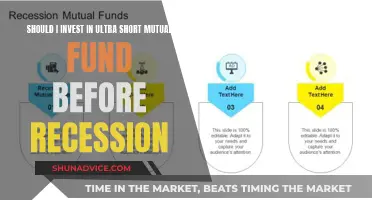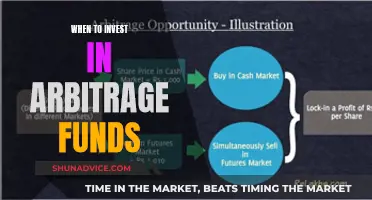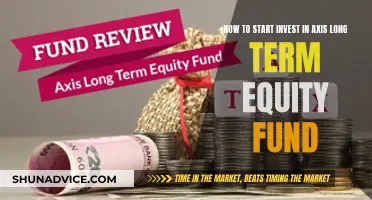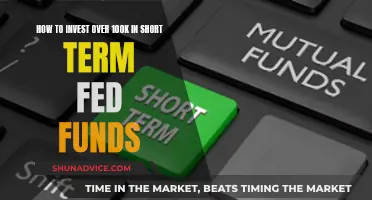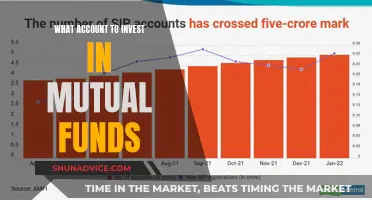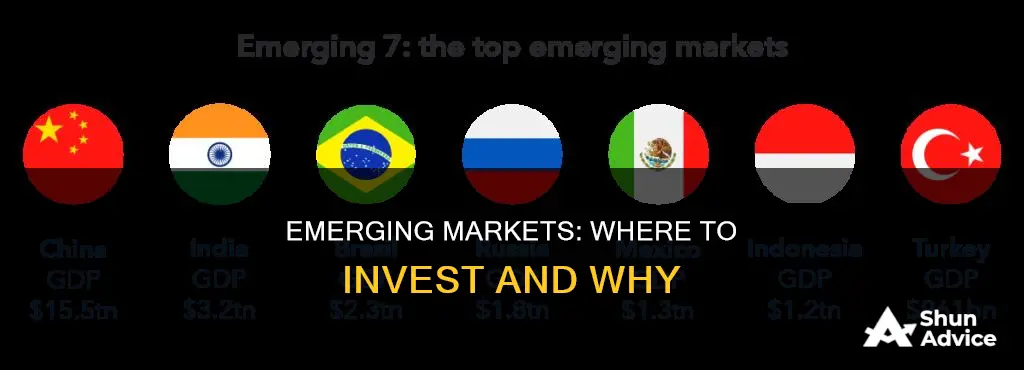
Investing in emerging markets funds can be a risky but rewarding endeavour. These funds invest in securities from countries with developing economies, such as China, India, Brazil, and Russia, which offer high potential returns but also carry more risk than developed markets. With the global economy expected to rebound, now may be a good time to consider investing in these funds for potential growth. Here are some key things to keep in mind when deciding which emerging markets fund to invest in.
What You'll Learn

Mutual funds vs exchange-traded funds (ETFs)
Mutual funds and exchange-traded funds (ETFs) are two popular investment vehicles for investors looking to diversify their portfolios. While both types of funds offer exposure to a wide range of securities, there are some key differences between them that investors should be aware of when making investment decisions.
One of the main differences between mutual funds and ETFs is how they are traded. Mutual funds can only be bought and sold directly with the fund provider at the end of each trading day, after the fund's manager has calculated the value of a share, known as the net asset value (NAV). In contrast, ETFs trade more like stocks and can be bought and sold on the open market with other investors throughout the trading day, offering intra-day liquidity. This makes ETFs a more attractive option for active traders who want the flexibility to trade intraday.
ETFs are typically passively managed, meaning they track a market index or sector sub-index, while mutual funds are usually actively managed by a fund manager or team who buy and sell securities within the fund to try to beat the market. As a result, ETFs generally have lower fees and expense ratios than mutual funds, which require more time, effort, and manpower for securities research and analysis. However, it's worth noting that a growing range of actively managed ETFs is now available to investors.
Mutual funds often have minimum investment requirements of hundreds or thousands of dollars, while ETFs can be purchased for the cost of a single share, plus fees or commissions. This makes ETFs a more accessible option for investors with limited capital. Additionally, ETFs offer tax advantages due to their passive management structure, as they tend to realise fewer capital gains than actively managed mutual funds.
In terms of which type of fund is better suited for investing in emerging markets, both mutual funds and ETFs can provide exposure to emerging markets. However, given the higher risk associated with emerging markets, the ability to trade intraday and the lower fees associated with ETFs may make them a more attractive option for investors looking to access these markets.
Bond Mutual Funds: When to Invest for Maximum Returns
You may want to see also

Diversification and asset allocation
Broad Emerging Markets ETFs invest in a diverse range of countries with emerging economies, such as India, Brazil, and China. On the other hand, Regional ETFs and Country ETFs allow investors to focus on specific regions or individual countries. For example, the T. Rowe Price Latin America Fund (PRLAX) offers exposure to Latin American countries like Brazil, Mexico, and Argentina.
When allocating assets, investors should consider the level of risk they are comfortable with. Emerging markets funds are generally considered high-risk, high-reward investments due to the volatility of emerging markets. However, they can provide growth potential greater than that of developed markets. For example, the Vanguard FTSE Emerging Markets ETF (VWO) offers broad exposure to various countries, including Brazil, Russia, India, Taiwan, and China, to mitigate the risk of poor-performing stocks.
Additionally, investors can diversify their portfolio by investing in different types of securities. Emerging market funds may specialize in either fixed-income or equity securities. Fixed-income investments, such as bonds, traditionally see less volatility than the stock market, but emerging market bonds may offer higher potential yields. Equity investments, on the other hand, tend to be riskier but can provide higher returns.
It is also important to consider the fees associated with different funds. Some funds, like the Vanguard FTSE Emerging Markets ETF (VWO), have low expense ratios, which can be attractive to investors concerned about high fees.
Retirement Planning: Safely Investing for Peace of Mind
You may want to see also

Country classifications
Companies are typically categorised based on the level of development of their economies. There are three main classifications: developed, frontier, and emerging.
Developed Nations
Developed nations, also known as industrial nations, have fully developed economies with technologically advanced infrastructure. They are considered low-risk, stable investments but offer lower returns than emerging markets.
Frontier Economies
Frontier economies are slightly less developed than fully industrialised nations but are more advanced than emerging economies. They present a middle ground in terms of risk and potential returns.
Emerging Market Economies
Emerging market economies are considered to be in the high-growth phase, with rapidly improving market environments. They offer higher potential returns than developed markets but also carry higher risks. These include political risk and liquidity risk, among others.
Factors influencing the classification of emerging markets include macroeconomic conditions, rapidly increasing gross domestic product (GDP) rates, political stability, capital market processes, and financial market trading and settlement procedures.
Some of the most well-known emerging markets include the "BRICS" nations: Brazil, Russia, India, China, and South Africa. In August 2023, BRICS invited six new countries to join: Saudi Arabia, the United Arab Emirates (UAE), Iran, Egypt, Argentina, and Ethiopia.
Broad vs Country Exposure
When investing in international ETFs, investors can choose between broad exposure and country exposure. Broad exposure seeks a diverse range of international growth opportunities, while country exposure focuses on specific countries, whether developed or emerging.
Diversification Benefits
Emerging market funds provide diversification benefits by spreading risk across a basket of stocks and multiple countries. This can help to mitigate the impact of market volatility in any single location.
Regional Focus
Emerging market funds tend to focus on the emerging markets of Asia and Latin America, rather than those in the Middle East, Africa, or Europe. However, some funds offer regional or country-specific exposure, such as the T. Rowe Price Latin America Fund, which provides exposure to Latin American countries like Brazil, Mexico, and Argentina.
Active vs Passive Funds
Emerging market funds can be either actively or passively managed. Actively managed funds, like the Fidelity Emerging Markets Fund, involve a fund manager actively selecting companies with strong growth potential and consistent cash flow. Passively managed funds, like the Vanguard Emerging Markets Index Fund Admiral, aim to track a specific market index and provide returns that mirror the index performance.
Equity vs Debt
Emerging market funds can specialise in either equity or debt securities. Equity funds invest in stocks of emerging market companies, offering the potential for higher returns but with higher risks. Debt funds, such as the Vanguard Emerging Markets Bond Fund, invest in sovereign debt or corporate bonds issued by emerging market governments or corporations, offering potentially higher yields than bonds in developed markets.
Index Funds: Utopia or Dystopia for Investors?
You may want to see also

Risk and volatility
Emerging market funds are considered high-risk, high-reward products. They are riskier than funds that invest in domestic equities or those of developed countries because emerging markets carry more risk. These include political risk, as emerging markets are still developing their economies and establishing industries.
Emerging markets are also known for their instability, with performance often coming in fits and starts. Some emerging-market countries are oil exporters, for example, Brazil, which made them particularly vulnerable in 2020 due to the decline in oil prices.
However, emerging markets have young demographics and growing middle-class populations, with the potential for greater growth than developed countries. They are starting at a lower level of development, which means they are positioned to deliver above-average returns.
Emerging market ETFs provide diversification by spreading out risk across a basket of stocks and a number of countries, thereby mitigating some of the uncertainty that can come with investing in less-developed markets.
Broad Emerging Market ETFs seek to invest in international companies across markets that are considered to have "emerging" economies, like India, Brazil, and China.
Regional ETFs seek to invest across countries in a specific part of the world, like Europe or the Asia-Pacific region.
Country ETFs seek to invest in individual countries, whether developed or emerging.
Utility Index Funds: When to Invest for Maximum Returns
You may want to see also

Long-term growth
Investing in emerging markets can be a good strategy for long-term growth, but it is important to remember that these investments carry a higher degree of risk than assets in the U.S. due to emerging markets risk, stock market risk, country risk, regional risk, currency risk, and political risk. However, to compensate for the high degree of risk and volatility, emerging market funds tend to offer higher potential returns over the long term.
- Vanguard FTSE Emerging Markets ETF (VWO): This fund has a low expense ratio, giving investors access to over 5,000 emerging-market stocks with total net assets of over $108 billion. Its broad exposure offers wide diversification across various countries, including Brazil, Russia, India, Taiwan, and China, to mitigate volatility from poor-performing stocks.
- IShares Core MSCI Emerging Markets ETF (IEMG): IEMG provides comprehensive exposure to emerging markets, with over 2,500 holdings and a focus on the information technology sector. It is up more than 4% year to date and 5.4% since its inception less than 10 years ago.
- Fidelity Emerging Markets Fund (FEMKX): FEMKX employs a diversified equity strategy for emerging markets and focuses on companies with strong growth potential, consistent cash flow, and high returns. The fund is diversified across emerging and developed markets, with exposure to various sectors such as information technology, healthcare, and industrials.
- American Funds New World Fund (NEWFX): NEWFX has a low minimum fund investment of $250 and provides exposure to both the U.S. equity market (about 22%) and emerging markets (about 44%). The portfolio is managed by experienced advisors who select countries based on factors such as the overall regulatory environment and market capital as a percentage of GDP.
- T. Rowe Price Emerging Market Stock Fund (PRMSX): This fund is suitable for investors seeking a more aggressive strategy with long-term diversification benefits. Its top holdings include well-known names such as Taiwan Semiconductor Manufacturing, Tencent Holdings, and Samsung Electronics.
- Schwab Fundamental Emerging Markets Large Company Index Fund (SFENX): SFENX holds most of its sector weight in financials, energy, and information technology. It corresponds to the returns of the Russell RAFI Emerging Markets Large Company Index, which captures the volatility of a fundamental index strategy.
- Vanguard Emerging Markets Bond Fund (VEMBX): This fund has a five-year track record and has outperformed its peers in the emerging market bond category. While bonds are traditionally less volatile than stocks, emerging market bonds may offer higher potential yields.
- Emerging Markets Internet & Ecommerce ETF (EMQQ): This ETF focuses on the growth potential of emerging markets in the internet and e-commerce industries. It has holdings from 17 countries, with China as the most significant presence at 62% of assets.
- KraneShares CSI China Internet ETF (KWEB): KWEB holds China-based companies that engage in internet-related businesses. It is suitable for investors comfortable with a concentrated approach, as it is exclusively focused on China.
- IShares ESG Aware MSCI EM ETF: This fund allows investors to gain exposure to companies in emerging markets that exhibit positive ESG (environmental, social, and governance) characteristics. China is the top country in the portfolio at 33.3% of assets, followed by Taiwan (16.0%) and South Korea (12.9%).
These funds provide a range of options for investors seeking long-term growth opportunities in emerging markets. It is important to carefully consider the risks and potential rewards of each investment option before making a decision.
Index Funds: When to Start Investing for Maximum Returns
You may want to see also
Frequently asked questions
Emerging markets offer the potential for long-term gains and greater growth than developed countries. They are also a smart diversification tool, providing growth potential greater than that of the U.S. and other developed markets.
Emerging markets are considered high-risk, high-reward investments. They are known for their instability and performance can be volatile, coming in fits and starts. There is also a higher level of risk associated with investing in overseas stocks.
Examples of emerging market funds include:
- Vanguard FTSE Emerging Markets ETF (VWO)
- iShares Core MSCI Emerging Markets ETF (IEMG)
- Fidelity Emerging Markets Fund (FEMKX)
- Vanguard Emerging Markets Index Fund Admiral (VEMAX)
- Wasatch Emerging Markets Select Fund Investor (WAESX)


